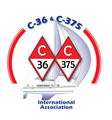I have a 1988 Catalina 36' MKII that doesn't seem to point even 45 degrees off the wind unless I am pinching in 20 knots of wind. My boat has a 130% genoea in good condition with the draft in the forward 1/3 of the sail and an older main. I often move the lead block from the genoea clue aft and sheet in until the genoea is almost against the spreaders. My old Catalina 27' used to point very high. Does anyone have any suggestions?

Tom,
I'm hoping some of the racers will comment here. There are some pretty awesome sailors on the forum! I assume you have 3-4 sets of tell-tales on your jib? Rather than moving the genoa car aft, I try to position it so that all sets of tell-tales are flipping at the same time. Car aft might be better for heavy winds, to spill air out of the top of the sail. Is your boom on or slightly above the center-line, even if the traveler car is well above the centerline? Outhaul tight to adjust the draft to 30+/- %? (You might want to re-build the outhaul in the boom - I upgraded mine to a 6:1 purchase and brought it back to the cockpit for easy adjusting). Mainsheet so that aft end of the top batten is parallel to the boom and top tell-tale occasionally flipping around to the backside? Backstay/forestay tight? Enough halyard tensions to get rid of wrinkles, but not create any shelves? I'm sure that others can add some more details. Hope this helps.
Tom Sokoloski
C36/375IA Past Commodore
Noank, CT
Fin keel is what is needed for higher pointing. Which keel do you have? For may years I was also not able to point higher than 45 even with fin keel. It turned out that the jib sheet was too tight. The forestay should not be very tight. There should be a slight curve towards the jib when properly trimmed. Also move the fairlead forward until all three tell tails break at the same time and the tell tails should be pointing back on both sides of the jib. These boats required at leas a 12 knots wind to start moving. In San Francisco bay it is not unusual to get 30 knots wind - that is when she is really moving.
Sail La Vie 1999 Catalina 36 MKII, M35B-17031, Coyote Point, San Mateo, CA
About Sail La Vie
I had similar problem. I bought the right tools and tuned my rig every Spring. My wing keel won't point better than Fin but it improved considerably.
Enrique
Talisman
1998 36 MK2 Hull #1673
Tall Rig Wing Keel
M35BC engine
Old Saybrook, CT Summer
South Glastonbury, CT Winter
Good tips from others on sail control. For the rig itself, forestay tension has significant impact on power vs. pointing. In light conditions you generally want to maximize the power of your sails, so more forestay sag is better. In heavy conditions or when you want to point high, less forestay sag is better. Assuming that all other aspects of your rig tune are correct, backstay tension is how forestay sag is adjusted. For boats without a backstay adjuster, this is never done under sail as it puts too much strain on the turnbuckles. The best overall tune for us seems to be towards a tight forestay.
Nick Caballero
Retired C36/375IA Mk II Technical Editor
The previous question about the keel is very significant. The shoal draft keels are not designed for pointing. If you have a shoal draft, you need to learn to foot the boat for speed more than point. For best results, use wind VMG. I feel the next thing to check is sail condition. I have done many racing programs where sails are bought each year, but I understand many racer/cruisers don't have the budget for constant new sails. I would categorize sail condition as 1-3 years old as excellent, 4-7 years as good, 8-15 years as fair. If a genoa is over 15 years old and there is a question about pointing angle... the answer is right there. To give an example: I competitively race a J-80. The sails we had been using were bought in 2009. Condition appeared to be good. Like most one-design race boats, lack of performance is greatly noticed when we are side-by-side. We got a new set this year. The upwind speed difference is 3/4 of a knot. Pointing angle increased, speed increased and the heel decreased.
Rig tune: For pointing, most of the time a tighter headstay is better. For flat water, go tighter. Choppy waves, ease the backstay and increase the forestay sag. This will add power in the headsail and give the boat some punch thru the waves. Shrouds: The leeward shrouds should be just moving when hard on the wind. Obviously, this tension varies with wind speed. That will keep the mast straight. What happens is the middle of the mast drops off to leeward and chokes the slot between the main and the genoa. With the trim of these two sails, you want the twist to match on the leeches. This also keeps the mast from moving and shaking the wind from the sails.
Bottom Condition: The condition of the bottom of the boat can have a huge impact. There is a reason many race boats dry sail the boat. How the bottom paint is applied makes a difference; rolled vs sprayed. If we remember that with sailboats, it is a relationship between power and friction. Usually power up top, friction below. A boat with a sprayed on bottom will perform better than a boat with a rolled on bottom. This can transfer to pointing angle because "point" comes from efficiency of the keel.
I apologize if this appears to be a bit long, but there are so many factors of why a boat will not point.
Scott Tuma
1984 C36TM